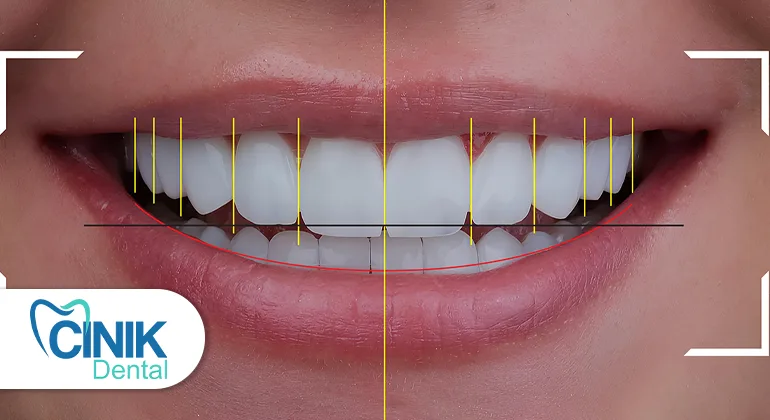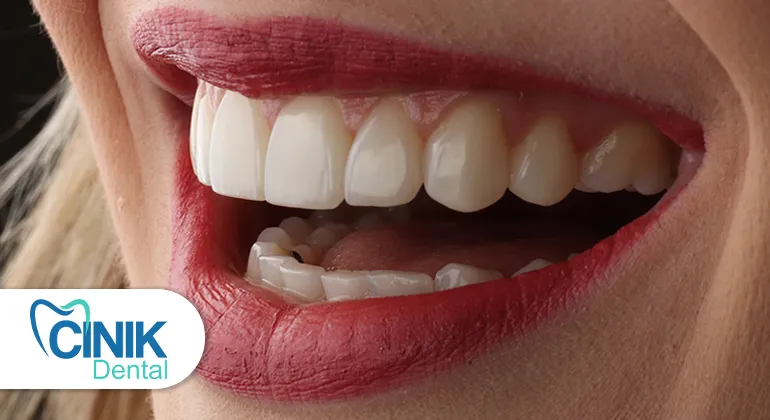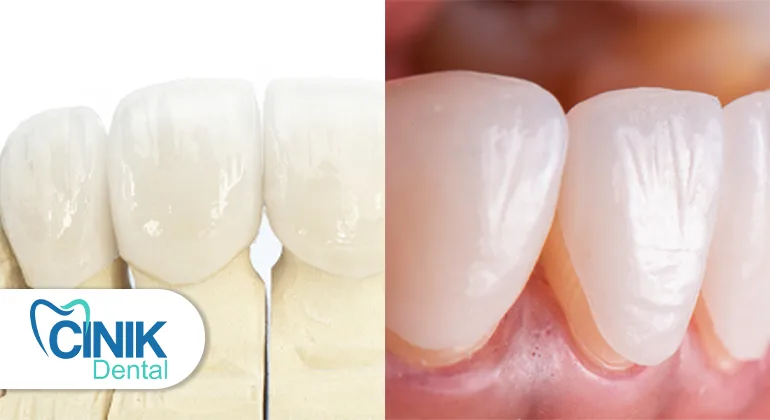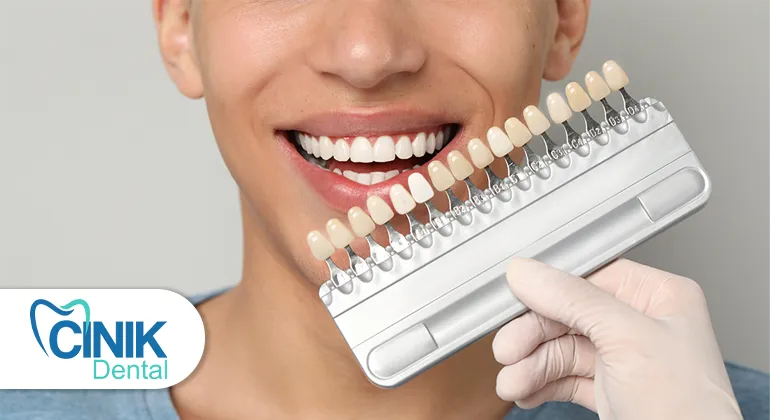Laminate Veneers: Smile Design Customization Based on Smile Type
Laminate veneers are among the most commonly preferred applications in modern aesthetic dentistry. However, a successful veneer treatment involves much more than just changing the color or shape of the teeth. Achieving a natural, harmonious, and aesthetic result is possible by customizing according to the patient’s smile type. Below are the details of how smile design personalization is achieved in laminate veneer applications:
What Does “Personality Reflection” Mean in Veneers?
Personality reflection in laminate veneers means capturing the patient’s overall character, age, gender, and social identity in their smile. The aim is to create a personalized, expressive smile rather than a generic one.
How Are Smile Characters Analyzed?
Soft – Feminine Smile
Characterized by rounded teeth edges and softened contours, with a broader smile arc. Typically preferred for women.
Bold – Masculine Smile
Defined by more angular and prominent teeth and a flatter smile line. Often suitable for men.
Youthful – Sporty Smile
Features slightly longer central incisors, shorter lateral teeth, and a dynamic overall appearance. Conveys energy and youth.
Mature – Classic Smile
A balanced proportion of tooth size and shape, delivering a natural yet refined expression.
The Role of Facial Shape, Speech Style, and Social Identity
Facial Shape
Angular teeth may complement a round face, while rounded teeth may soften a square face to achieve facial harmony.
Speech Style
The visibility of teeth during speech, and tongue placement during certain phonemes, can help determine appropriate tooth length and shape.
Social Status and Profession
Some professions call for a more conservative or pronounced smile. For instance, a corporate executive may benefit from a classic and balanced design, whereas an artist might prefer a more distinctive and expressive look.
How Are Artistic Touches Applied to Tooth Contours?
Yes, two teeth with the same size and shape can appear entirely different depending on how the dentist designs their contour and surface texture. This is where artistic flair becomes essential in smile design.
Examples:
Flat and Angular Contours: Straight, angular tooth edges convey a sharper, more masculine appearance — ideal for bold or masculine smile types. For example, sharply defined corners on the upper central incisors can project a more assertive look.
Rounded and Soft Contours: Slightly rounded edges and softer curves give teeth a more feminine and elegant aesthetic — ideal for soft or feminine smiles. For example, gently rounded lateral incisors and canines create a more delicate expression.
Surface Texture (Tooth Microstructure): Natural teeth are not perfectly smooth — they exhibit microscopic textures. Reflecting this texture on veneers enhances realism. A flawlessly polished surface may appear artificial. Microgrooves and ridges influence how light reflects, adding depth and authenticity. For instance, vertical striations (perikymata) common in youthful teeth can be mirrored in veneers to convey vitality and youth.
Why Are “Natural Imperfections” Preferred in Smile Design?
The concept of “natural imperfection” refers to subtle asymmetries or micro-spaces intentionally incorporated into aesthetic dental treatments to achieve a more believable and natural smile.
Are Minor Rotations, Asymmetries, or Gaps Intentional?
Yes — absolutely. Perfect symmetry does not exist in nature. Excessive perfection often appears artificial. Therefore:
Slight Rotation: A very slight rotation in one tooth can make the alignment feel naturally occurring.
Minor Gaps (Diastema): A small gap between the front teeth may be perceived as charming and unique, enhancing the smile’s individuality.
Asymmetry: Tiny variations in tooth lengths (especially lateral incisors or canines) add realism and dynamism to the smile.
How Are These Imperfections Turned into Advantages for a Natural Look?
These so-called “flaws” add personality and character to the smile. Instead of an overly symmetrical and idealized appearance, slight irregularities make the smile appear truly authentic — as though the person was born with it. This eliminates the “overly done” aesthetic and delivers a more natural “these are my real teeth” impression.
The Secret to Harmony in Veneers: Tooth-Lip-Eye Axis Planning
A smile is not just about the teeth, it must harmonize with the entire face. In veneer design, harmony depends on carefully planning the relationship between the teeth, lip contours, eyes, and facial midline.
How Should These Relationships Be Established?
Tooth-Lip Relationship:
- Smile Line: The incisal edges of the upper teeth should follow the curve of the lower lip during smiling, creating a youthful and attractive smile.
Tooth Visibility: How much of the upper teeth are visible at rest and during smiling is crucial. With age, upper teeth show less while lower teeth become more visible — this must be factored into planning.
Buccal Corridor: The dark space between posterior teeth and the mouth corners when smiling should be balanced — neither too large nor too narrow — to ensure a natural smile line.
Tooth-Eye Relationship
Ideally, the midline between the central incisors should align with the horizontal line passing through the pupils (barring facial asymmetry). Eye openness and smile dynamics also play a role in smile harmony.
Tooth-Facial Midline Alignment
The contact point between the upper central incisors should align as closely as possible with the facial midline. Even if not perfectly symmetrical, there should be no noticeable deviation.
Aesthetic Proportions
Width-to-length ratios of teeth should align with golden ratio principles. Additionally, proportions between teeth, such as central-to-lateral ratios, must be harmonious.
When Patients Request Designs That Conflict With Their Expression
Sometimes, patients may request very specific cosmetic changes (like “super white” or “extra long” teeth) that do not align with their facial features or natural expression. In such cases, the dentist plays a crucial guiding role.
How Does the Dentist Provide Guidance?
Comprehensive Analysis and Education
The dentist thoroughly evaluates the patient’s facial anatomy, lip dynamics, speech habits, and aesthetic expectations. Then, they educate the patient — using visuals and examples — on why their request may appear unnatural or artificial.
Digital Smile Design (DSD)
Modern smile design software allows simulation of different tooth shapes, lengths, and colors on the patient’s photos or videos. Patients can preview their desired “super white” or “extra long” teeth and often realize that the result does not look natural — helping them make more informed choices.
Mock-Up Application
Temporary wax-up models are placed in the patient’s mouth to preview how the proposed design interacts with facial features in real life. This helps the patient directly compare their original request with the dentist’s recommendation — often resulting in a shift toward a more natural option.
Psychological Approach
The dentist should understand the patient’s underlying motivations. Sometimes, patients are subconsciously influenced by celebrity aesthetics or idealized images. By exploring these drivers, the dentist can better align expectations with functional and aesthetic outcomes.
Offering Alternatives
The dentist proposes other smile design options that better complement the patient’s natural facial expression. Throughout this process, open communication and mutual trust are essential.
Read more: Crafting the Perfect Hollywood Smile Design: Where Art Meets Dental Science
In Conclusion
Customization in laminate veneer treatments is not just about aesthetic outcomes, it is a form of artistry that boosts patient confidence and well-being. Therefore, a detailed planning process with an experienced aesthetic dentist is essential for long-term success.




Leave a Reply